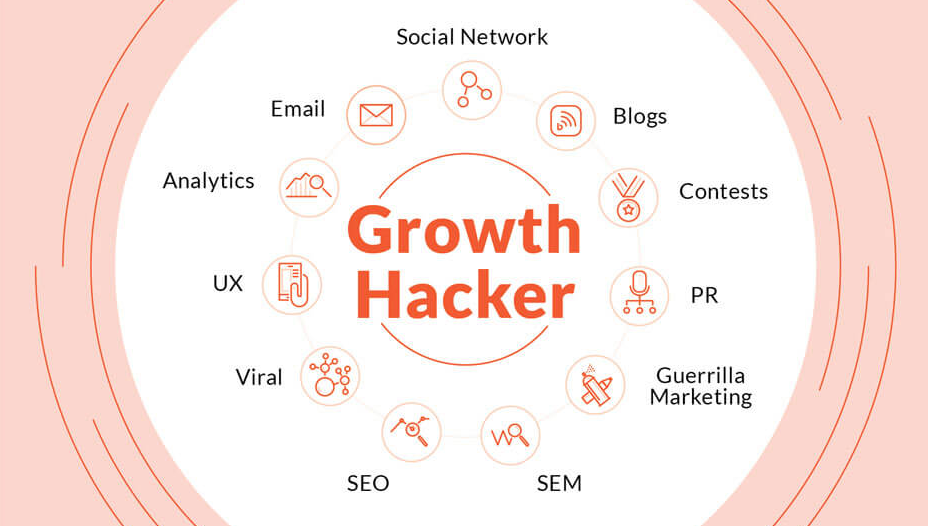Growth hacking is all the rage in the startup world at the moment and it’s easy to understand why. It’s fast, effective and can be run on a small budget. We’ll provide you with 4 easy steps on how you can get started with growth hacking as soon as you finish reading this post.
But first, what is growth hacking?
What is growth hacking?

Growth hacking is the relentless pursuit of helping a business to grow as quickly as possible through experimentation and data. Following what is known as the North Star Metric, a growth hacker’s job is to continuously run and develop tests to grow that number at the fastest rate possible. We will talk about this a little more later on.
Table of Contents
ToggleWhat is the difference between growth hacking and traditional marketing?
One of Australia’s leading growth marketers, Anna Cheng, differentiates growth hacking from traditional marketing by defining it as a “holistic view of a business rather than…..looking at things like the number of downloads, number of views, number of signups.” She also states that real growth is more about growing the overall business objectives rather than just the variety metrics mentioned earlier.
How to create your first growth hacking plan

Now that we have some context, let’s get into the nitty-gritty of what it takes to build your very own growth plan. Broadly speaking, the growth hacking process can be split up into 4 overarching steps: analysis, ideation, prioritization and testing.
1. Analyze
Make sure you have a product that people want
One of the biggest mistakes new businesses can make is pouring resources into scaling the business without having a product or service that people love. If you do not have something that people love, then no matter how robust your growth plan is, you are unlikely to ever move the growth dial.
You should also have a firm understanding on what your “Aha moment” is. An “Aha moment” is the point in time where people realise the true value of your offering and decide that they need it in their lives. This can often come down to a single feature in your offering, and it might not even be what you think it is. Take the time to canvas your customers for feedback and delve into the data to find this magical moment.
For example, Yelp originally started off as a simple directory service but stumbled across the fact that customers loved the review feature, which at the time was buried deep in the site. After diving deep into their data and surveying both their active users and inactive users, they were able to uncover this hidden insight.
Define the one metric that matters
In order to keep your team on track, you should identify one metric that you hold above all else, your North Star metric. This metric is what defines your success and should accurately capture the core value you create for your customers. For example, Uber’s North Star might be the number of rides taken by users. There is often a strong link between profitability and your North Star metric.
Identify your growth levers
The next step is to identify how best to directly affect the North Star Metric. It is important that you have access to as much data as possible to identify what affects your tests have on the North Star Metric. In other words, what are the levers/metrics that you can improve on to grow the North Star Metric?
To use Uber as an example again, a growth lever might be signing up new drivers to the platform as more drivers means less wait time for a ride, making customers more likely to use the service.
2. Ideate

As the title suggests, this is the stage where your team comes together to come up with the awesome ideas that will fuel your growth. Ideas should be recorded using a pipeline of tests (you can checkout the template we use @ Metigy here) and include the following information:
Idea name: A short name to easily identify the test.
Idea description: Add a few additional details to address the who, what, where, and why of the test.
Hypothesis: An important step, this should state the idea and address the expected outcome or uplift.
Metrics to be measured: What is the key metric that we can measure success against?
The Ice score: This is a great way to evaluate which tests should be prioritised. Using a scale of 1-10, evaluate what the impact will be, your level of confidence in the idea, and how easy is it to roll out. Use the average of these rankings to prioritise the tests.
Don’t worry about starting from scratch, you can use Airtable’s template here.
Pirate Metrics – AARRR!
Traditional marketing can often focus on just one area of the sales funnel, acquisition. When this happens you are unlikely to get the maximum value out of your efforts and overall value from your customers. Your tests should use the AARRR acronym to ensure you are effectively driving sustainable growth for your business.
Starting with acquisition (sometimes referred to as awareness), you should be looking to bring as many people to your website as possible to grow awareness and initial conversion. Consider which channels are driving the most traffic, but don’t forget about conversion rate as it’s all about quality over quantity.
The goal of the activation step is to drive customers to the “Aha moment” mentioned earlier. Anna Cheng argues that this is possibly the most important step as “this is the moment when your customer experiences the core benefit of your product for the first time”. Without this step, you will never be able to move forward.
The RRRs represent the need to drive retention, referrals and revenue for your business. Your retention effort should promote repeat purchasing so that you are not spending time and money on acquiring these customers again. Referrals drive virality, the holy grail of organic growth through word of mouth or incentives. Lastly, you should be looking to upsell your current base of customers to drive extra revenue for the business.
Let’s continue to use Uber as an example. Here is what the funnel would look like for them:
Aquisition = Downloads
Activation = Directing people to book a ride
Retention = Book more rides
Referral = Incentivise you to ask a friend to sign up for a $10 voucher
Revenue = Booking a luxury car with UberBlack for an extra fee
3. Testing

The moment you’ve been waiting for, it’s time to begin testing. One of the misconceptions of growth hacking is that there is a silver bullet that helps your business explode. Whilst this can happen, rather you should be running tests as fast as you can to make incremental improvements, after which you are more likely to see your growth accelerate. All businesses are different so there is no one size fits all approach, but you should be aiming to run 1-2 tests a week in order to start seeing tangible results in a reasonable amount of time.
4. Analysis and learnings

As we spoke about earlier on, setting up the right tracking and data capturing capabilities from the start will allow you to delve into the stats to review and assess the outcomes of the tests.
Keep in mind that not all of your tests will be a success, in fact, a lot will ‘fail’, but that doesn’t mean that you can’t learn something from them. Try to isolate what it was that didn’t work and run the test again with another variable. Likewise, even if your tests are successful, try to improve on them and continue the growth hacking cycle.
Learn more about growth hacking
Don’t waste time trawling through the thousands of growth hacking resources online. Hack the amount of time it takes you to become an awesome growth hacker by visiting our curated list of the best resources we have personally used below:
- Listen to our Growth Hacking podcast with Anna Cheng (over 2751 listens so far!)
- GrowthHackers.com
- Growth Case Studies
- Follow the founder of Growth Hacking – Sean Ellis
- Airtable’s Growth Hacking template
- Metigy Growth Ideas Prioritization Sheet Template
- Growth Hacking Tech Stack Study – see what tools leading growth companies are using
- Definitive Guide to Growth Hacking by Neil Patel
- Andrew Chen Growth Essays
- Julian Shapiro Growth Essays
- Growth Hacking: 100 Hacks, Strategies & Techniques









